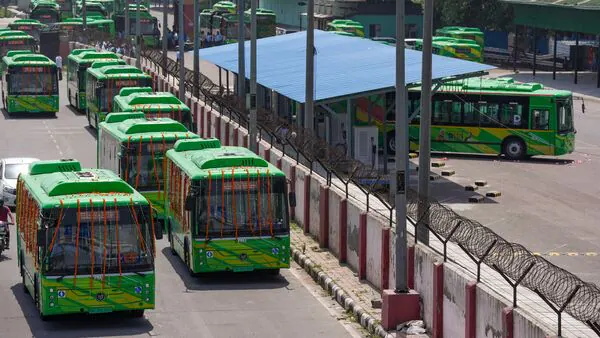
Mint Explainer: How India Aims To Reduce The Cost Of Plying E-Buses On Its Roads With An Upfront Subsidy
NEW DELHI: India aims to incentivise 14,000 e-buses by FY28 to run them on its roads under the ₹10,900 crore PM E-Drive scheme. With about 3,500 e-buses being sold every year in the country, the government is working towards reducing the upfront cost as well as the operating cost of these e-buses.
Mint explains the maths behind reducing the operating expenditure (opex) of state transport agencies running e-buses given that the upfront capital expenditure (capex) accounts for a higher share of the total cost of ownership (TCO) of such vehicles.
Why do e-buses need fiscal support?The good news is that electric buses do not have carbon emissions. The bad? They are at least twice as expensive as diesel buses - often costing upwards of ₹1 crore an e-bus. So, the government has a programme, the ₹10,900-crore PM E-Drive scheme, to reduce the burden of the 'green premium' which in industry parlance is the extra cost consumers have to pay for using green products compared to less sustainable choices.
More importantly, electric buses run for a relatively long period of time every day, unlike other vehicle segments such as scooters that largely remain idle for most of the day. This coupled with the public transport nature of e-buses means that transport gets decarbonised a lot more versus an electric scooter - making a strong case for subsidizing battery-powered buses.
Also Read | Govt's e-truck scheme set to hit the road as rare-earth norms ea Why does capex and opex play a part in this?Commonly, fiscal incentives have always covered the upfront capital cost of the vehicle – the capex – not only in India, but across Europe and China. But, this is not the only cost of a vehicle.
The total cost of ownership (TCO) of any vehicle is the upfront capex along with the cost of operating and maintaining it, i.e., the opex.
Multiple analyses, available publicly, have shown that in a cycle of over 10 years, the TCO of electric buses is lower than that of diesel buses, because for the fossil fuel vehicle, the cost of fuel and servicing or spare parts often drives up the TCO in the long run, making them economically viable.
On the other hand, with e-buses, the capex accounts for a large share of the TCO. Charging infrastructure costs and power costs are mostly lower than gasoline costs, giving e-buses an advantage in opex. Also, with fewer parts in an e-bus, its maintenance and repair costs are also lower than that of a diesel bus.
Also Read | Ministry seeks to shift ₹4,891 cr allocation for e-trucks, e-buses to F Which expense does the government cover for e-buses?Under the PM E-Drive scheme, the government helps a buyer of e-buses like a transport utility with a 20% to 35% support to cover the cost of procurement. The same scheme mandates that state transport agencies enter into long-term contracts with manufacturers to pay them on a per-km basis. The e-bus makers will retain the ownership of the bus, while state transport agencies operate them.
The government's sops will be given to state transport agencies, and passed onto manufacturers gradually as e-buses are operated more.
At the same time, only those state transport agencies which have deposited a payment security under the PM E-bus Sewa Payment Security Mechanism (PSM) are eligible for the PM E-Drive incentives. Under this PSM, the Centre has created a fund of approximately ₹3,400 crore to pay manufacturers on behalf of state transport operators, in case they default on the per-km fee.
Also Read | Can incentives, duties help India claw back its crane mark Shifting capex to opexIn August 2025, government think tank NITI Aayog recommended that the burden of capital costs be shifted to operation costs, as these are lower for electric vehicles than comparable petrol-diesel vehicles.
A 2022 government tender for about 5,450 electric buses fetched a per-km rate of about ₹45, compared with approximately ₹75-90 for a similar diesel bus. Large demand aggregation also leads to lower prices being discovered. The central government has also floated a massive 10,900 e-bus tender under the scheme, to deploy these buses in five cities -- Delhi, Hyderabad, Ahmedabad, Surat, and Bengaluru.
A suggestion the Aayog made was to decouple batteries from vehicles, and leasing them separately over a longer period of time. This would reduce the capex of a bus, as batteries account for 40-50% of the cost of an electric vehicle. At the same time, it would shift capex to opex allowing more purchases of EVs.
NITI Aayog also floated the idea of creating a robust industry for leasing EVs.“Given that the capital cost of trucks and buses is unaffordable to small owners, nurturing the development of a leasing industry for these vehicles would go a long way in easing the situation," the NITI noted in its Unlocking a $200 billion opportunity: Electric Vehicles in India report.
Legal Disclaimer:
MENAFN provides the
information “as is” without warranty of any kind. We do not accept
any responsibility or liability for the accuracy, content, images,
videos, licenses, completeness, legality, or reliability of the information
contained in this article. If you have any complaints or copyright
issues related to this article, kindly contact the provider above.


















Comments
No comment